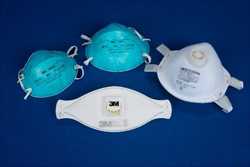Infection Control
Infection Control in Health Care Settings
Tuberculosis (TB) transmission has been documented in health care settings where health care workers and patients come in contact with people who have TB disease.
People who work or receive care in health care settings are at higher risk for becoming infected with TB; therefore, it is necessary to have a TB infection control plan as part of a general infection control program designed to ensure the following:
- prompt detection of infectious patients,
- airborne precautions, and
- treatment of people who have suspected or confirmed TB disease.
In all health care settings, particularly those in which people are at high risk for exposure to TB, policies and procedures for TB control should be developed, reviewed periodically, and evaluated for effectiveness to determine the actions necessary to minimize the risk for transmission of TB.
The TB infection control program should be based on a three-level hierarchy of control measures and include:
- Administrative measures
- Environmental controls
- Use of respiratory protective equipment
Administrative controls are the first and most important level of the hierarchy. These are management measures that are intended to reduce the risk or exposure to persons with infectious TB. These control measures consist of the following activities:
- Assigning someone the responsibility for TB infection control in the health care setting;
- Conducting a TB risk assessment of the setting;
- Developing and implementing a written TB infection-control plan;
- Ensuring the availability of recommended laboratory processing, testing, and reporting of results;
- Implementing effective work practices for managing patients who may have TB disease;
- Ensuring proper cleaning, sterilization, or disinfection of equipment that might be contaminated (e.g., endoscopes);
- Educating, training, and counseling health care workers, patients, and visitors about TB infection and TB disease;
- Testing and evaluating workers who are at risk for exposure to TB disease;
- Applying epidemiology-based prevention principles, including the use of setting-related TB infection-control data;
- Using posters and signs to remind patients and staff of proper cough etiquette (covering mouth when coughing) and respiratory hygiene; and
- Coordinating efforts between local or state health departments and high-risk health-care and congregate settings.
The second level of the hierarchy is the use of environmental controls to prevent the spread and reduce the concentration of infectious droplet nuclei. This includes two types of environmental control.
- Primary environmental controls consist of controlling the source of infection by using local exhaust ventilation (e.g., hoods, tents, or booths) and diluting and removing contaminated air by using general ventilation.
- Secondary environmental controls consist of controlling the airflow to prevent contamination of air in areas adjacent to the source airborne infection isolation (AII) rooms; and cleaning the air by using high efficiency particulate air (HEPA) filtration, or ultraviolet germicidal irradiation.
 The third level of the hierarchy is the use of respiratory-protection control. It consists of the use of personal protective equipment in situations that pose a high risk of exposure to TB disease.
The third level of the hierarchy is the use of respiratory-protection control. It consists of the use of personal protective equipment in situations that pose a high risk of exposure to TB disease.
Use of respiratory protection equipment can further reduce risk for exposure of health care workers to infectious droplet nuclei that have been expelled into the air from a patient with infectious TB disease. The following measures can be taken to reduce the risk for exposure:
- Implementing a respiratory protection program;
- Training health care workers on respiratory protection; and
- Educating patients on respiratory hygiene and the importance of cough etiquette procedures.
- Page last reviewed: April 26, 2016
- Page last updated: April 26, 2016
- Content source:


 ShareCompartir
ShareCompartir